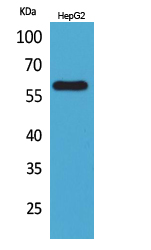ASIC3 Polyclonal Antibody
- 产品详情
- 实验流程
- 背景知识
Application
| WB |
|---|---|
| Primary Accession | Q9UHC3 |
| Reactivity | Human |
| Host | Rabbit |
| Clonality | Polyclonal |
| Calculated MW | 58905 Da |
| Gene ID | 9311 |
|---|---|
| Other Names | ASIC3; ACCN3; SLNAC1; TNAC1; Acid-sensing ion channel 3; ASIC3; hASIC3; Amiloride-sensitive cation channel 3; Neuronal amiloride-sensitive cation channel 3; Testis sodium channel 1; hTNaC1 |
| Dilution | WB~~Western Blot: 1/500 - 1/2000. ELISA: 1/20000. Not yet tested in other applications. |
| Format | Liquid in PBS containing 50% glycerol, 0.5% BSA and 0.09% (W/V) sodium azide. |
| Storage Conditions | -20℃ |
| Name | ASIC3 (HGNC:101) |
|---|---|
| Function | Forms pH-gated heterotrimeric sodium channels that act as postsynaptic excitatory receptors in the nervous system (PubMed:10842183, PubMed:11587714, PubMed:9744806, PubMed:9886053). Upon extracellular acidification, these channels generate a biphasic current with a fast inactivating and a slow sustained phase (PubMed:10842183, PubMed:9744806, PubMed:9886053). ASIC3 is more sensitive to protons and gates between closed, open, and desensitized states faster than other ASICs (By similarity). Displays high selectivity for sodium ions but can also permit the permeation of other cations (PubMed:9744806, PubMed:9886053). As a neuronal acid sensor, probably contributes to mechanoreception, acid nociception, and heat nociception (By similarity). By forming heterotrimeric channels with ASIC2, generates a biphasic current with a fast inactivating and a slow sustained phase, which in sensory neurons is proposed to mediate the pain induced by acidosis that occurs in ischemic, damaged or inflamed tissues (By similarity). |
| Cellular Location | Cell membrane; Multi-pass membrane protein Cytoplasm {ECO:0000250|UniProtKB:Q6X1Y6}. Note=Preferentially expressed at the plasma membrane of the soma and cellular processes of neurons (By similarity). In part cytoplasmic in cochlea cells (By similarity) Localized in specialized sensory nerve endings (By similarity) {ECO:0000250|UniProtKB:O35240, ECO:0000250|UniProtKB:Q6X1Y6} |
| Tissue Location | Expressed by sensory neurons. Strongly expressed in brain, spinal cord, lung, lymph nodes, kidney, pituitary, heart and testis. |
For Research Use Only. Not For Use In Diagnostic Procedures.
Provided below are standard protocols that you may find useful for product applications.
BACKGROUND
Cation channel with high affinity for sodium, which is gated by extracellular protons and inhibited by the diuretic amiloride. Generates a biphasic current with a fast inactivating and a slow sustained phase. In sensory neurons is proposed to mediate the pain induced by acidosis that occurs in ischemic, damaged or inflamed tissue. May be involved in hyperalgesia. May play a role in mechanoreception. Heteromeric channel assembly seems to modulate channel properties.
终于等到您。ABCEPTA(百远生物)抗体产品。
点击下方“我要评价 ”按钮提交您的反馈信息,您的反馈和评价是我们最宝贵的财富之一,
我们将在1-3个工作日内处理您的反馈信息。
如有疑问,联系:0512-88856768 tech-china@abcepta.com.























 癌症的基本特征包括细胞增殖、血管生成、迁移、凋亡逃避机制和细胞永生等。找到癌症发生过程中这些通路的关键标记物和对应的抗体用于检测至关重要。
癌症的基本特征包括细胞增殖、血管生成、迁移、凋亡逃避机制和细胞永生等。找到癌症发生过程中这些通路的关键标记物和对应的抗体用于检测至关重要。 为您推荐一个泛素化位点预测神器——泛素化分析工具,可以为您的蛋白的泛素化位点作出预测和评分。
为您推荐一个泛素化位点预测神器——泛素化分析工具,可以为您的蛋白的泛素化位点作出预测和评分。 细胞自噬受体图形绘图工具为你的蛋白的细胞受体结合位点作出预测和评分,识别结合到自噬通路中的蛋白是非常重要的,便于让我们理解自噬在正常生理、病理过程中的作用,如发育、细胞分化、神经退化性疾病、压力条件下、感染和癌症。
细胞自噬受体图形绘图工具为你的蛋白的细胞受体结合位点作出预测和评分,识别结合到自噬通路中的蛋白是非常重要的,便于让我们理解自噬在正常生理、病理过程中的作用,如发育、细胞分化、神经退化性疾病、压力条件下、感染和癌症。






